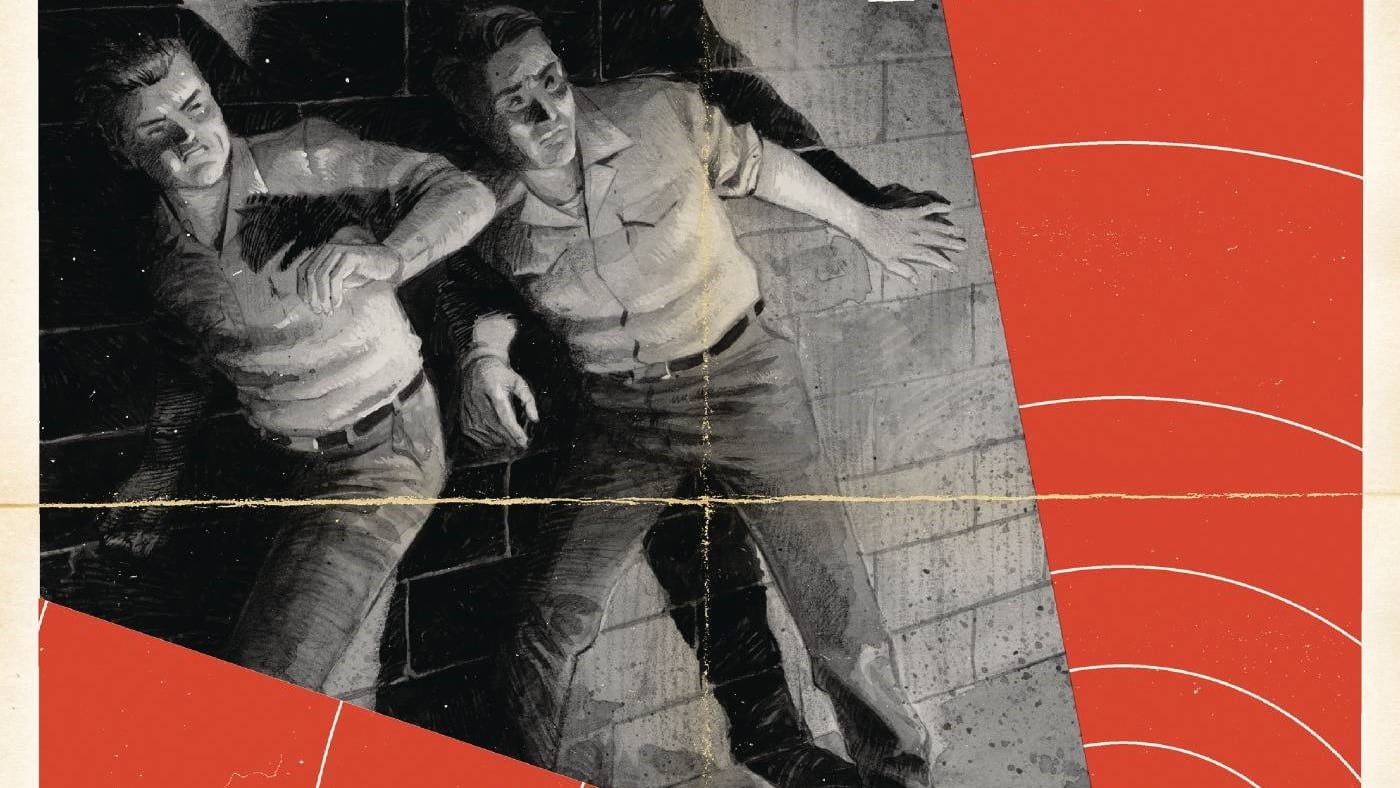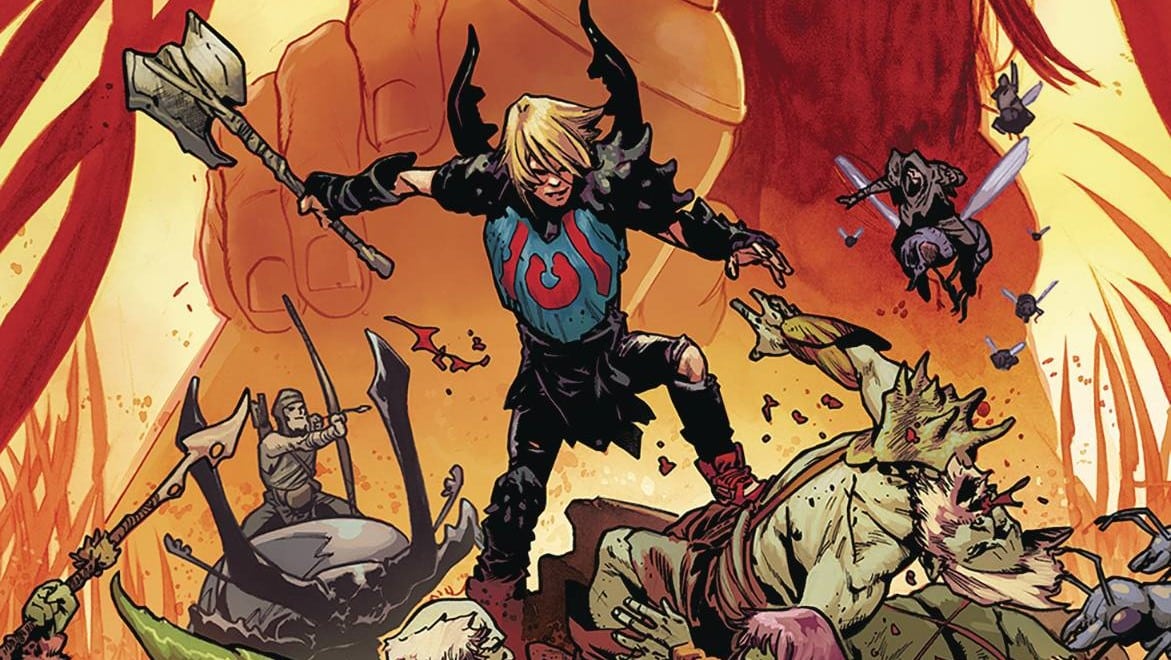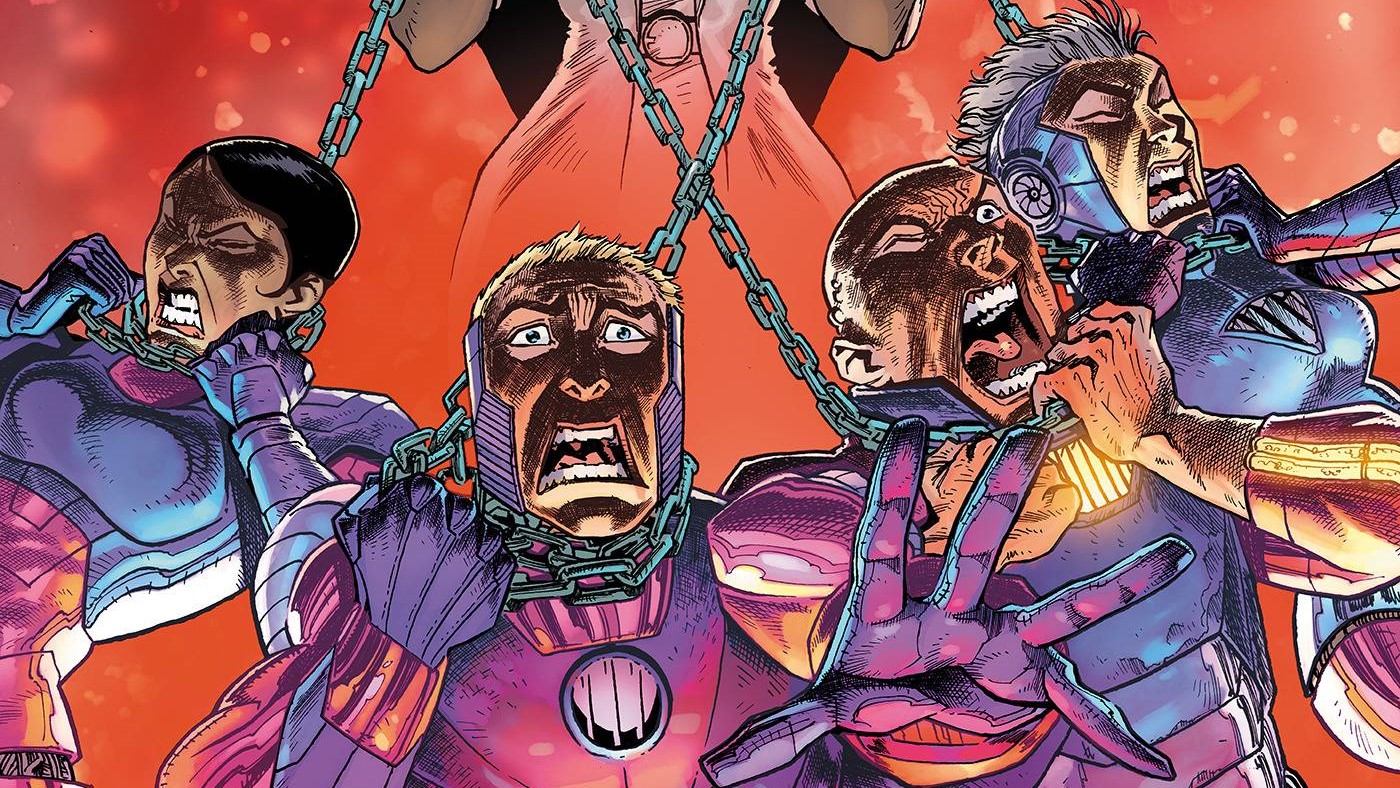Some tiny boys go to the beach, and some big girls are mean to them. Yup, softcore porn has come to ComiXology in Cousins #1 by Tonara Cluric.
Roy is still drifting toward the red planet, accompanied only by memories and his faithful rovers and otherwise alone. Or is he? Traveling to Mars #5 is written by Mark Russell, drawn by Roberto “Dakar” Meli, colored by Chiara Di Francia, lettered by Mattia Gentili and published by Ablaze.
It’s looking bad for our little neighborhood of serial killers. Well, not as bad as it is for the piles and piles of dead cops in Where Monsters Lie #2, written by Kyle Starks, drawn by Piotr Kowalski, colored by Vladimir Popov, lettered by Joshua Reed and published by Dark Horse.
It’s time to venture into space … and into the creepy-crawly parts of our own bug brains in Paklis #1, written, drawn, colored and lettered by Dustin Weaver, and published by Image.
Will Nevin: I’m trying a new bit, Ian! Each week, we’re going to open with something I think is going to be objectively awful and see how long it takes you to quit. Sound like fun? Also, I think I’m eventually going to work some reverse psychology on myself in that while trying to pick something bad, I’m going to stumble onto something good.
Ian Gregory: This is sort of like pre-rolling your dice to get all the bad numbers out. It’s unscientific mumbo-jumbo, but it just might work! If I haven’t quit in the last year of reviewing with you, Will, I don’t think I’ll start now. You’ll have to get inventive if you want to be rid of me.
Will: *plots in awfulness*
Cousins #1: What Was That?
Will: Before you get any ideas, I didn’t pick this because I wanted to start covering softcore femdom pornography — we’ll leave that to Leftovers After Dark. But I wanted to point this out as something that is currently on the ComiXology platform … a thing that at one point had standards.

To be totally clear, I’m not anti-porn. Not at all! But this is so awful in even what it is trying to be, using what is clearly computer-generated art and deploying some terrible writing.
Ian: Obviously, this is unsettling and unusual and not well-made, but I also can’t really bring myself to dislike it because it feels so much like punching down. It’s bewildering in a casual way, and it’s strange that this is on ComiXology of all places, but that’s about all there is to it.
Will: And that is, of course, the point. There hasn’t been a single advantage to the full-on Amazon/ComiXology merger, and this lack of quality control on the platform is one more sign of the rot that has seeped into what was — while maybe never truly great — at least something that was reliable.
Traveling to Mars #5: People Are People, Too (Like Robots)

Will: I mentioned this briefly last time, but I do feel like this is one (the only?) Eisner nomination that feels right. After reading so many books that feel empty, that feel pointless, it’s nice to have something with some meat on it, and I was particularly impressed by the art in two places here: 1) the continued excellent way in which Meli is able to anthropomorphize the rovers, this time the one we see dying on Mars, and 2) the (mostly) naked splash page of Roy and Candy. OK, I promise that’s the last semi-pornographic thing we’re going to talk about this week.
Ian: I like this series, but I can’t help but be a little self-conscious about liking it. I’m worried that it won’t really nail the ending, or it will just give way to the kind of dismissive intellectualism that has bothered me about Russell’s other work. In terms of art, though, you’re right that this series is really working visually. For a book fundamentally about a man sitting in a chair and waiting to die, there’s a lot of visual variety here.
Will: And another two notes on the writing. First, I don’t guess I was surprised when Russell brought up religion since that seems to be a common theme in a lot of his work, but I don’t know that it felt necessary here. Didn’t exactly feel forced, but it didn’t come off as essential either. Second, Russell — fresh off his nod to the aging U.S. Space and Rocket here in Huntsville — has done more of his Alabama history homework: Eufala actually has a monument to “Leroy Brown,” a largemouth bass that lived seven years in captivity and displayed some signs of intelligence, like learning that fish hooks are bad. I had never heard of Leroy before, so I got a guy teaching me something about my own damned state.
Russell likes to play with anthropomorphization, it seems, with the fish and the rovers in this series and what he did in Flintstones. I don’t know if that means anything, but I felt like pointing it out regardless.
Ian: Well, there’s a continued throughline about people who are considered “disposable.” In fact, the beef company uses that exact word in describing both Roy and the convicts who are manning their rivals’ spaceships. There’s a sense that these companies put themselves above others, that they are more human than their “lessers,” the common folk like Roy.
Anthropomorphization encourages us to question our own preconceived notions of order. Is Roy just as valuable as an object? Are the objects themselves more real than how we treat them? Roy degrades himself in reference to Leroy, but I think that we should read that as them both having some kind of dignity. The “betters,” the corporations, would never willingly compare themselves with a fish because they lack that basic sense of empathy.
Will: Finally, I thought the ending here — that other space goons are out to beat Roy to Mars — sort of cheapened the whole endeavor. Like, maybe this won’t devolve into some big action thing and my fears will be for naught, but I enjoy my quiet sad book of Regret, The Man.
Ian: I feel like this may end up being a fakeout. I’m thinking about the prison boat sequence in The Dark Knight, a surprisingly sensitive bit that mainly depicts prison inmates as possessing just as much humanity as everyone else, and even more than the prison guards. I’m hoping that this is a bait-and-switch that will encourage us to think about these convicts, sentenced to death just the same as Roy, as real people, too. If not, then I think it will pretty much undercut the entire point of this series.
Where Monsters Lie #2: It’s Getting Late Early

Will: In this second issue, I think we get three important things: 1) some great Kyle Starks one-liners, 2) buckets upon buckets of gore and 3) a sense that this series is going to be fairly decompressed, in that it’s not going to play out over days or weeks. Police are getting wholesale slaughtered at our happy little compound, Ian. This already seems like the endgame.
Ian: It does feel like we’ve plunged straight into the “final night” of a horror movie (or six). I’m OK with that, because I do think the longer we explore the mechanics of this serial killer villain community the more the concept will weaken. It works great as a single idea, but I’m not sure it will hold up to extended “lore building” or whatever.
Will: Like, I’m not mad we’re not getting more exposition, but I think trying to put a real world framework on slasher movie nonsense can lead to some interesting things. But maybe Maniac of New York has already done that (which reminds me — there’s another chapter of that story I need to read. Or maybe we need to read it?)
Ian: We spend a lot of time getting in the head and history of Agent Hayes, but that creates a bit of a problem in that I’m not sure I care about him at all. He’s a government agent in charge of hunting monsters, which sounds like it should be cool but really he’s just pigheaded and overconfident. Because we spent all of the first issue with the main cast of lovable idiots (aka the serial killers), I think I’m fundamentally on their side. I just felt like we spent a lot of our limited time in this series with a character who isn’t particularly likable or compelling.
Will: Some real contenders for SFX of the Week in this one, weren’t there? Art continues to be really solid — which is what you want when the script calls for copious amounts of viscera.
Ian: Loved the half-page of the flamethrower, and I loved the setup pages of cops wandering around while the killers got ready in the background. They’re just so hapless!
Paklis #1: Finally, Something with Our Work Ethic

Will: Finally, Ian, we dive into a series that began all the way back in 2017 — only to resurrect this year with its sixth issue. I think we’ve found a kindred spirit, friendo.
Paklis is an anthology series written and drawn by Dustin Weaver, and as is standard with all such anthology projects, readers are going to have their personal preferences for individual stories. For me, here it was “Mushroom Bodies,” a surreal mix of body horror and insanity that was a nice little combo. I think it worked better than the other two stories because it was a one-shot that avoided the space/science fiction territory that the other two pieces reveled in.
Ian: “Mushroom Bodies” definitely works best on its own, which is of course the intention. It’s disgusting in all the right ways. I love body horror, but I’m extremely weak to insects. They terrify me, and so this freaked me out in a way that I won’t forget for a long time. I’d recommend just reading it and I won’t say anything else, because I don’t want to think about bugs any more.
Will: I’ve made this point with writer/artists before, but I’ll hit it again here: They rarely find a right balance with their words. A dope like Sean Gordon Murphy loves to drown his pages in paragraphs of prose, and we have the opposite here: Weaver really lets his art do the talking. In a story like “Mushroom Bodies,” that works because there’s not much text required — we clearly see our protagonist losing his marbles and possibly transforming into a cockroach. But in the more high-concept space war stuff, I think we could use a little more explaining.
Ian: I think it’s a hard balance to make. I’m not opposed to leaving off lots of backstory and plot explainers, and I think that the amount of vagueness I’ll tolerate is directly proportional to the strength of the art. As a result, I’m willing to tolerate quite a lot of vagueness here. I think it helps that, in the two SF stories, the settings seem like classic, time-worn ideas. It’s Starship Troopers and all that. I never really felt like a lack of understanding about the setting was getting in the way of my enjoyment of the stories.
Will: What stood out for you visually? And, no, you can’t say the bug stuff because that’s mine. So cringingly perfect.
Ian: For me, it was the switch to the story “Sagittarius A*,” when the book goes from color to black and white, and vertical to horizontal. It was a really potent switch, which did a great job highlighting the change in tone between stories, and I love the rendering on the black and white in that story. The super dense environments and characters make a great contrast to the sketchier, sparse colors of “Amnia Cycle.”
Does This Smell OK?
- Sound Effects Watch: As alluded to above, there’s tons of great SFX in Where Monsters Lie, but my winner for this week is the “SP-MORT” of a trouble knife attack on a cop, part of a sequence of incredible effects.
- Rapid fire questions:
- What would be the most tragic household appliance for the Flintstones?
- Will: Let’s say some kind of thing with bioluminescence that’s rigged up to provide light … that slowly dims over time.
- Ian: What do you think their garbage disposal is like? Some sort of poor creature forced to eat slurried garbage.
- What’s your plan for survival if you get stuck in a slasher film?
- Will: Hiding. Hiding like the little nancy boy I am.
- Ian: I guess I’d become a born-again virgin.
- If you had to turn into a bug, which one would you prefer it to be?
- Will: Something with wings? But not one that stings — I’m a lover, not a fighter.
- Ian: I hate bugs, but it would probably be cool to be one of those kick-ass hercules beetles.
- What would be the most tragic household appliance for the Flintstones?
- Louisiana Russian cake sounds like leftover cake bits soaked in rum … which sounds pretty good, actually.
- Some 19th century Danish painters apparently used leftover beer mash to create canvases. Was this the first scratch-n-sniff technology?
- If you throw leftover deli meat into your macaroni and cheese, you should be drawn and quartered. NO. BAD.







